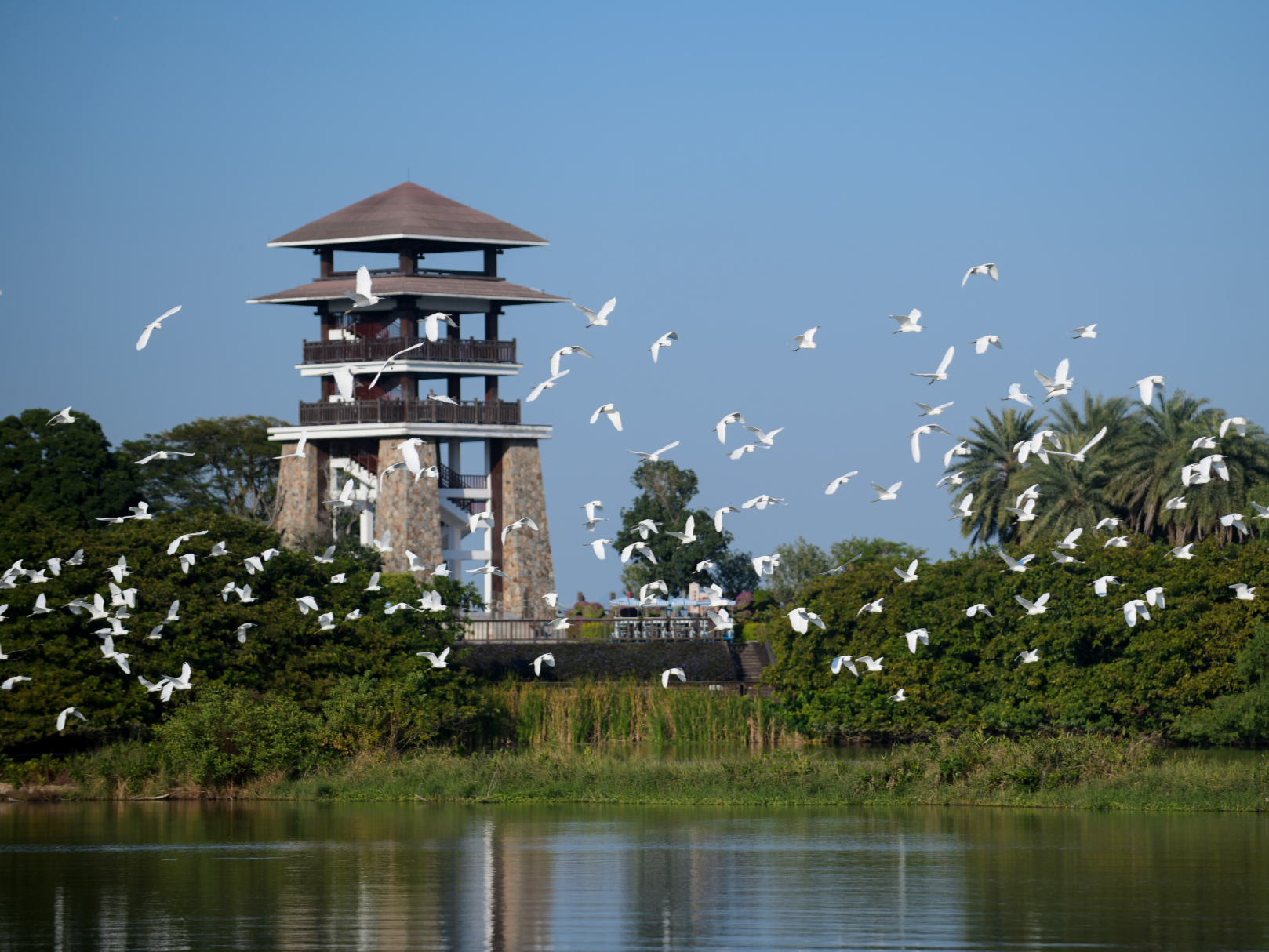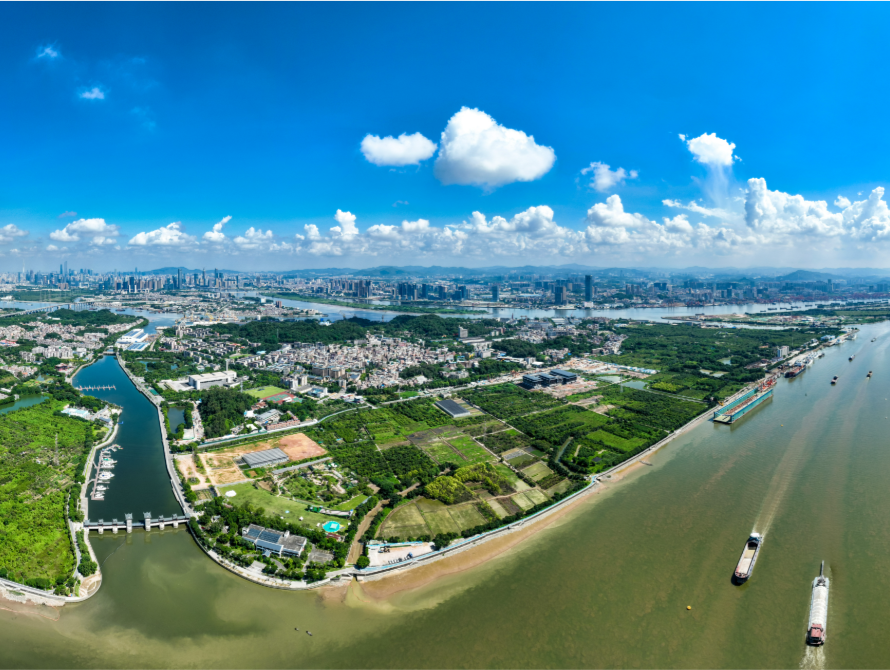
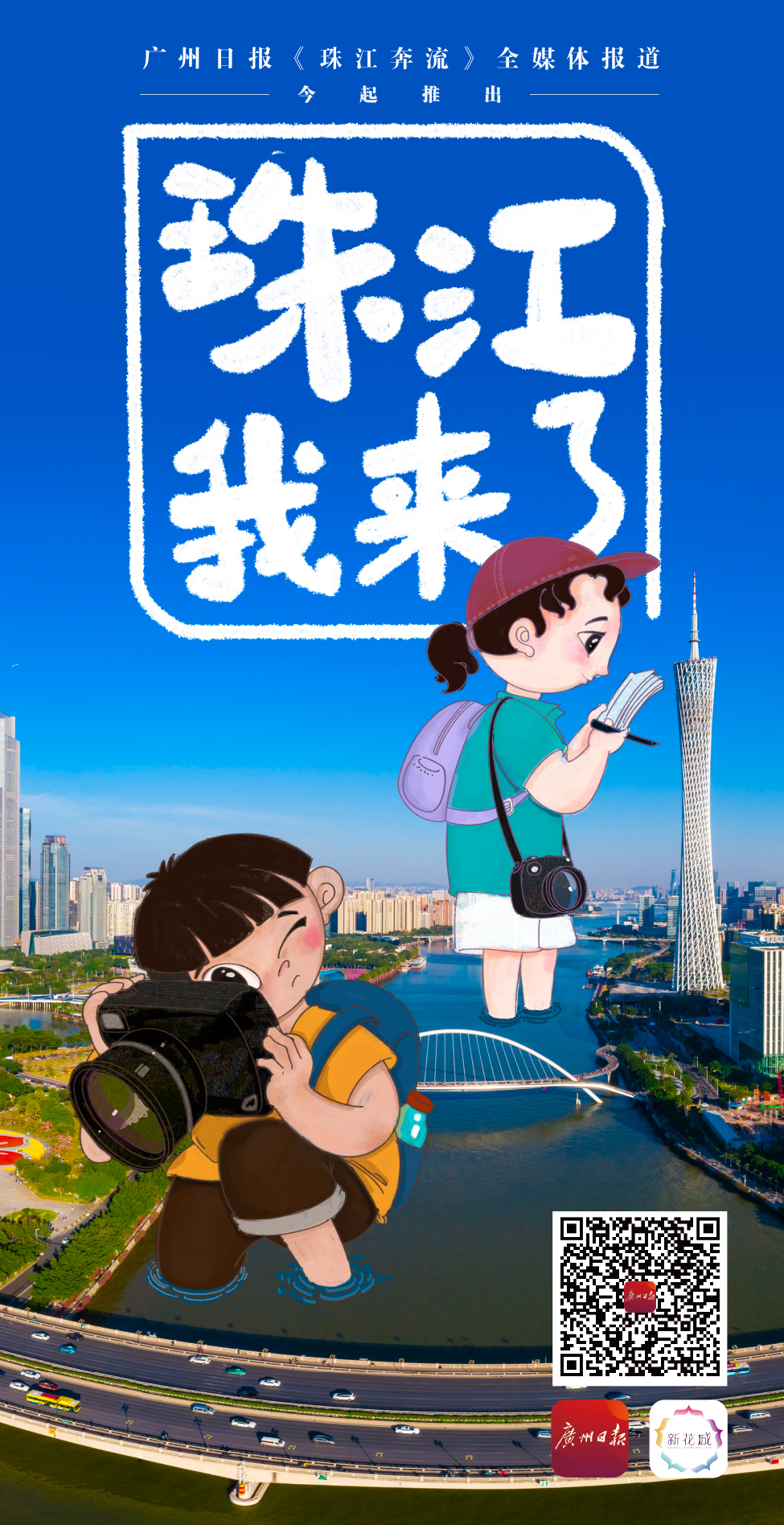
Opening remarks
Since the 18th National Congress of the Communist Party of China, General Secretary Xi Jinping has traveled north and south, up and down the great river, looking around again and again to protect the mother river; Stare again and again to plan high-quality development.
The Pearl River is the mother river of Guangzhou. For more than 2000 years, the big rivers and big cities have coexisted with each other. The vitality of a thousand year old commercial capital is surging among the billows, which bears the dream of the city in the rush of thousands of miles, and the character and spirit of Guangzhou people are nurtured in the return of thousands of rivers. At present, Guangzhou is striving to realize the new vitality of the old city and "four new and brilliant cities". The Pearl River coast aims to build itself into a world-class waterfront vitality area and high-quality development model. The big river city will also be a rising tide.
To see the Pearl River is to see Guangzhou, the Bay Area and China. Guangzhou Daily today launched the theme report of the 20th National Congress of the Communist Party of China, "Listen to the words of the General Secretary", "The General Secretary leads me to make contributions to a new era, the Pearl River rushes". It sent a team of elite soldiers and powerful generals to form a whole media team, invited experts and citizens to carry out in-depth visits throughout the Pearl River channel, or down the river or back up, to explore the beauty of clean water and shore, and listen to the sonority of the waves, To show the vivid stories and the power of the times in the rush of the Pearl River.
The surging Pearl River flows towards the sea. For thousands of years, Mother River has nourished the land of Guangzhou.
The islands scattered on the Pearl River are like bright pearls in the river. The river separates at one end of the island and meets again at the other end. The two sides of a river become four banks, or even six banks. The islands in the middle of the river surrounded by water have become urban areas, urban reception halls, music islands, industrial islands, modern agricultural islands, or retain their original ecological appearance, just like green boats, leaving a quiet and cool city.
The island in the middle of the river is not only integrated into the city, but also kept away from it. The Draft of Guangzhou Land Space Ecological Restoration Plan (2021-2035) proposes to protect and make good use of 45 river islands, build the Pearl River ecological island chain that is harmonious with nature, symbiotic with cities, and shared with citizens, and realize the harmonious coexistence of "city, water, and island".
Recently, the all media reporter of Guangzhou Daily visited several representative islands in the heart of the Pearl River, taking you into its day and night to feel its movement and stillness.
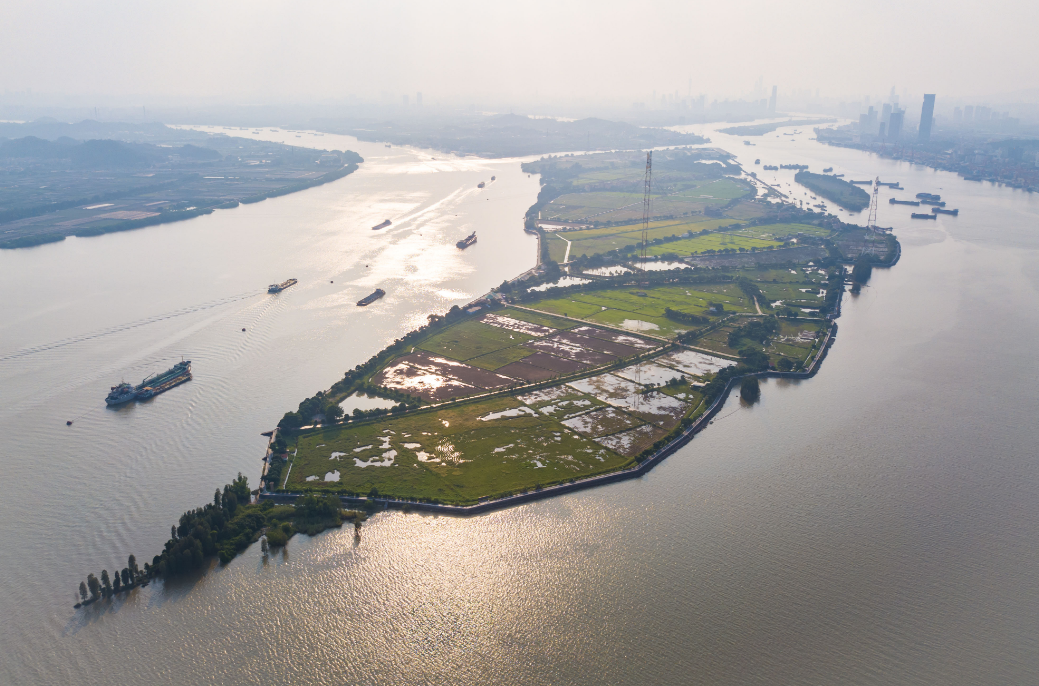
Dajisha
☀ day ☀
Daji Beach is painted with egrets and dances
This is the favorite of photography lovers
In the early morning, fish bellies turn white in the east. On the Haixinsha, a popular river island in Guangzhou, there are already citizens running and exercising in the morning near the Pearl River. After a night of rest, Guangzhou, a mega city, woke up.
Haixinsha is the venue for the opening and closing ceremonies of the Guangzhou Asian Games. It is full of green and vitality. One side is the landmark Guangzhou Tower, and the other side is the Central Business District of Pearl River New Town. One island, one tower, and one city constitute the most shining city living room in Guangzhou. "The beautiful shape of the island in the middle of the river makes a contribution to the construction of the city living room." Hu Gang, president of Guangzhou South China Urban Research Association and professor of Jinan University, said that the utilization of the developed island in the middle of the river should focus on highlighting publicity, demonstrating urban culture, and focusing on the integration of ecology and people, and the city. Last June, the first pedestrian bridge across the river in Guangzhou - Haixin Bridge was opened, making Haixinsha Island and Ersha Island truly integrated into the life of citizens.
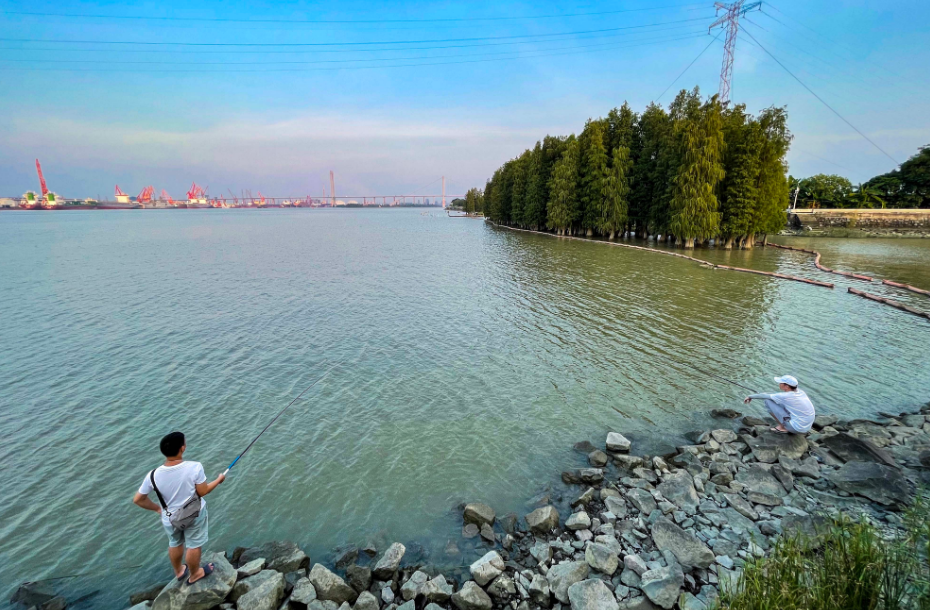
There are citizens fishing on the bank of Dajisha.
The Guangzhou International Biological Island, not far from Haixinsha, is leveraging its ecological value. The biological island, formerly known as "Guanzhou Island", is shaped like a boat. In the more than ten years since the "opening of the island", the bio island has gathered more than 500 bio pharmaceutical enterprises. In the future, there will also be a world-class innovative bio pharmaceutical industry cluster.
Dajisha, which is different from Guangzhou International Biological Island in style, has no cars or bridges, and is known as the "Xanadu of Guangzhou". When the reporter visited, he found that the dancing egrets painted on Daji Beach were the most interesting subjects for photographers. Low yielding rice ears, vigorous old trees and lush wild flowers were all children's favorite "friends". Citizens ride and take a walk around the island along Bidao Road, enjoy the open river scenery, the river wind, and enjoy a comfortable life.
Along the Pearl River, you can see the sea gull island is crowded with people, and tourists can enjoy the sea view of Shiziyang, mangroves and the pastoral scenery of the water; Or pick Lingnan fruit on the farm, taste the fresh vegetables on the island, and experience a "farm joy". This beautiful island has become a popular tourist destination.
Haiou Island is located at the foot of Lianhua Mountain, on the shore of Shiziyang Ocean, surrounded by pearl water. It is the largest ecological island in the Pearl River basin of Guangzhou. In this regard, Panyu District proposed to build the four villages of Seagull Island into a beautiful rural group with "green heart and emerald seagulls in the bay area", a water town characteristic leisure agriculture.
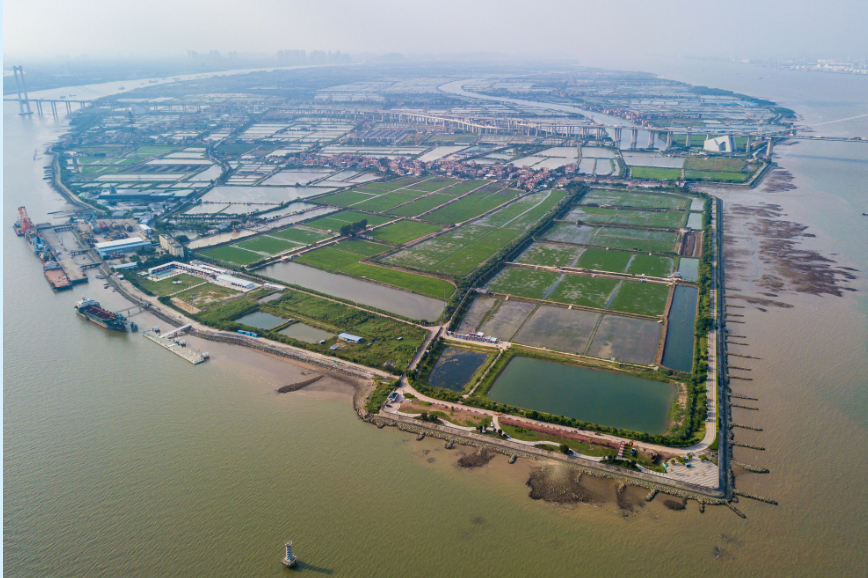
Seagull island
Rice grows in the field, fish play in the water, and ducks swim among the rice.
In midsummer, the seedlings of Jiashuo Farm on Haiou Island are green. In the field ditch, there are sometimes croakers jumping out of the water, ducks appearing and disappearing in the paddy field... A picture of pastoral scenery unfolds slowly, which is a vivid portrayal of the three-dimensional ecological breeding model of "rice+fish+ducks". In the farm, the 25 mu rice experimental field is planted with Yuan Longping giant rice, Yuan Longping super hybrid rice, etc. About 20000 fish and 50 ducks are stocked in the waterways around the rice field.
Ecology is the background of the seagull island and also the development advantage. Wang Ruilong, a researcher at South China Agricultural University, told the reporter that ecological planting and breeding models such as "rice fish symbiosis" and "rice duck co farming" are agricultural ecological models for long-term development of paddy fields in South China, which can improve land utilization and ecological environment, increase income through fish and duck farming while ensuring rice yield, and promote food security and stability, and help farmers increase income. "The island has a dense water network, which is suitable for the promotion of ecological circular agricultural models such as' rice fish symbiosis', 'rice duck co farming'." Wang Ruilong introduced.
In addition to continuous paddy fields, Haiou Island also has rich fishery resources. Haiou Island covers an area of 36 square kilometers. Originally, it was not an island. It was composed of three sandbanks and was divided by two "Li" (small rivers). "Every year after September of the lunar calendar and before the rain in February of the next year, salt water flows back into the island through two 'limes'. During the half year salt water period, plants cannot grow and people and animals cannot drink water. In 1958, we blocked the head and tail of the two' limes' and enclosed them into fish ponds to store fresh water for irrigation and agricultural production." Chen Jintang, a villager of Shabei Village, said, Now the total area of river network on Haiou Island is 45000 mu, and the area of fish pond aquaculture is about 20000 mu.
In the view of fishery experts, Guangdong Hong Kong Macao Greater Bay Area and Guangdong play an important role in the national fishery, and Seagull Island is the core area of the "fishery kingdom". On June 10 this year, the Panyu District Fishing Port Economic Zone in Guangzhou, Guangdong Province was inaugurated. The 80 square kilometer area, including the central fishing port of Lianhua Mountain and Haiou Island, was designated as the starting area of the Panyu District Fishing Port Economic Zone. With the combination of ecological advantages and integration of industry, city and people, it will create a new engine for high-quality development.
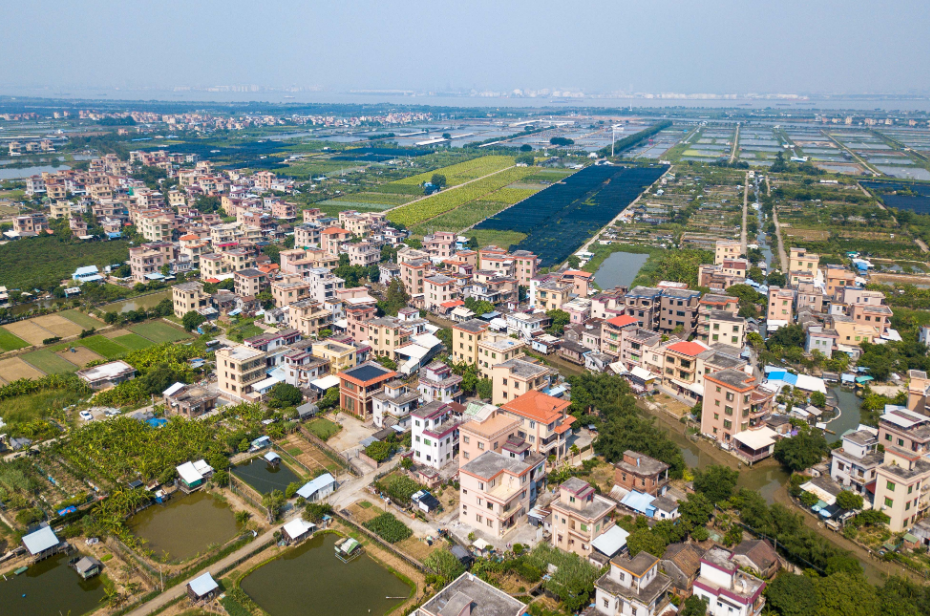
Residential buildings on seagull island.
☽ Night ☽
The chameleon tree lizard that preys on mantis rests on a branch
The marlin that can live out of water lives on the reef
As night fell, the busy Huangpu Port was brightly lit. On the Dajisha Island across the river, tourists scattered, clamoured back and insects roared on the scene. A quiet world of wild animals and plants has opened.
The reporter followed Wu Yongbin, a plant expert from South China Agricultural University, and Wu Haolin, a bird watcher, to Dajisha by ferry to explore the "dark night area" in the city. The island is embellished by the moonlight, accompanied by the river wind and the chirping sound of insects, showing a natural side.
After the beginning of autumn, the egg sheaths laid by praying mantis become yellow brown, and attach to the rough tree trunk to enter a long waiting period. They will hatch when the weather gets warmer next year. Luck is very important for the praying mantis to survive the winter. Once it encounters natural enemies, the praying mantis can only become food for other creatures. At night, the chameleon tree lizard, which preys on the mantis, is holding the branches in its arms and legs. The sound of "pa pa" was heard from the plantain leaves nearby, and the spotted legged pan tree frog, which also hunted mantis, performed "leaf floating" kung fu. Its limbs were long and thin, and its body color changed due to the environment. Generally, its back was light brown, and it was dark brown at night. The flower narrow mouthed frog, which feeds on ants, hides in a tree hole with a round body and a loud voice like a cow's roar.
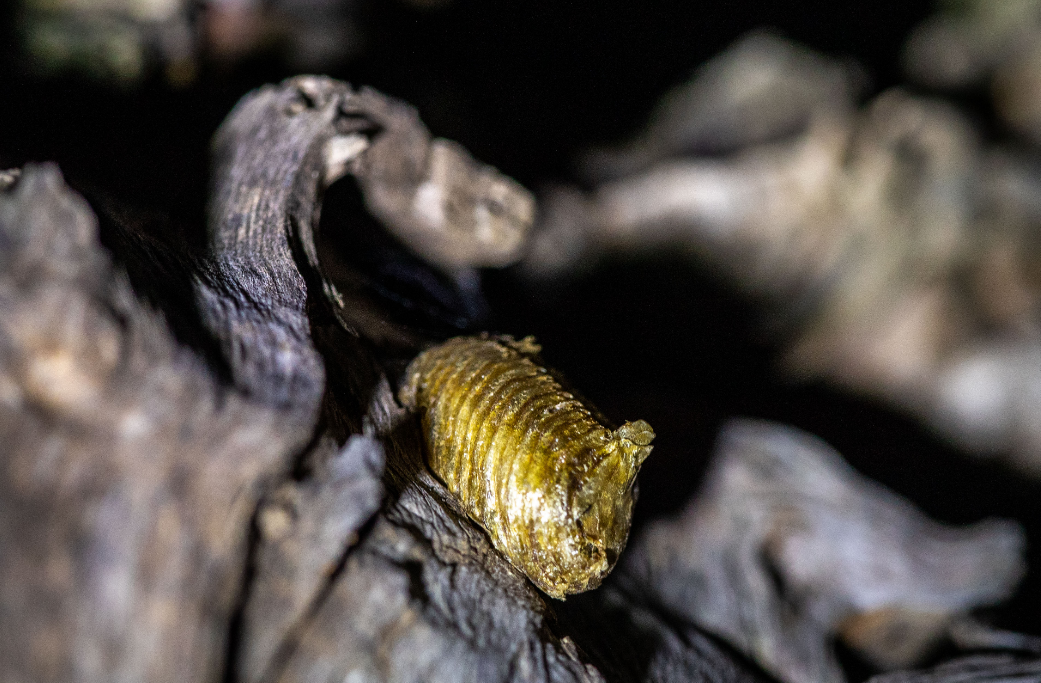
The egg sheath of a praying mantis.
It is easy to encounter nocturnal insects when exploring the island in the middle of the river at night. Cockroaches can be seen dancing on many branches and leaves to sense the surrounding environment. However, on the old tree a few meters away, the white fronted spider, the natural enemy of cockroaches, was lying on the branches looking for food. In addition to the woods, there are many toothless oriental xiangshou crabs, Chinese oriental xiangshou crabs and tender mud crabs hidden in the grass and on the beach. Next to the crabs are the marlin fish. The temperature is not low at the moment, and this kind of fish can be seen everywhere on the rocks on the bank that can temporarily escape from the water life.
Dajisha, on which many animals and plants live, is a river island in the Huangpu waters of the Pearl River. The surrounding coastline is 6.02 kilometers long. According to the old man Li Shuilin on the island, there were two villages on the island at first, Dajisha and Shengyuzhou. The islanders came from Panyu, Xinjiao and other places. Now there are about 100 people living on the island. Among the numerous river islands in Guangzhou, Dajisha Island is one of the few islands that are not accessible to vehicles, bridges and boats. It has preserved a more primitive natural style and has become a treasure land for wild animals and plants in the city.
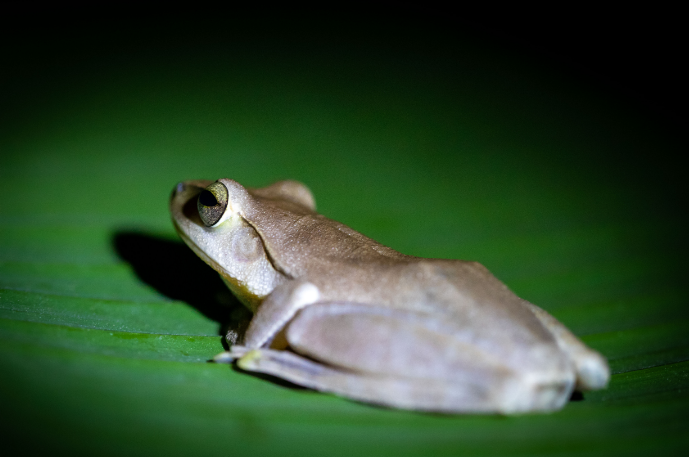
Spotted legged Pan tree frog.
Wu Haolin introduced that Dajisha Island became popular in the bird friendly circle in early 2020 because of the appearance of spotted frog on the island, which is the third record of spotted frog in China. Spotted breasted frog can be seen in Central Asia and West Asia, winters in southern Europe, Africa, India and other places, and is not common in southern China. It likes to live in plain grassland, lakeside shrub and riverside shrub. For this reason, some people speculate that the spotted breasted frog came to Dajisha during migration. The ecological conditions on the island are excellent, and the dense reeds just become its ideal habitat.
In order to see the style of the spotted breasted frog, Wu Haolin came to the island to visit. "I'm lucky. I can see it in the afternoon". He also saw many rare birds on the island, and rarely saw chestnut ducks. Chestnut duck is a national second-class key protected wild animal. The natural beach environment in Dajisha has created a comfortable environment for chestnut duck. "On the island, many birds are not afraid of people. They hold their heads high in the paddy field and walk around like they are in their own living room," Wu Haolin said.
What role does the island play in the city? Hu Huijian, vice president and secretary-general of Guangdong Zoological Society, made a metaphor that the island in the middle of the river is equivalent to a natural "canteen" for animals. "Undeveloped river islands have fluctuation areas, and the rising and falling tide will bring nutrition from the river water to the island, which is the reason why animals like to gather on the island." As a post station for animals, especially birds, the island is equivalent to a stepping stone of urban ecological corridors, leaving space for natural ecology to rest and enjoy health.
Compared with land, the development degree of Jiangxin Island is relatively low. Every night, the islands scattered on the Pearl River constitute the "dark night area" of the city, providing habitat for wild animals and plants. Wu Yongbin introduced that artificial elements such as lights, asphalt roads and tall buildings have an impact on animals and plants. As far as plants are concerned, light may affect flowering and fruiting, making their growth cycle shorter. Just as people turn off the lights to sleep, so do plants. Hu Huijian explained, "Many animals control their behavior by judging the changes in the external environment. For example, some animals reproduce based on the length of sunshine. Once the city is clear all night, animals are prone to miscalculation, leading to reproductive disorders."
From the perspective of protecting plant germplasm resources, Wu Yongbin believes that islands are natural species gene banks. Due to the lack of communication between islands and land and human intervention, some species are able to retain and reproduce. "There are some undeveloped river islands far from land in Guangzhou that may have such value".
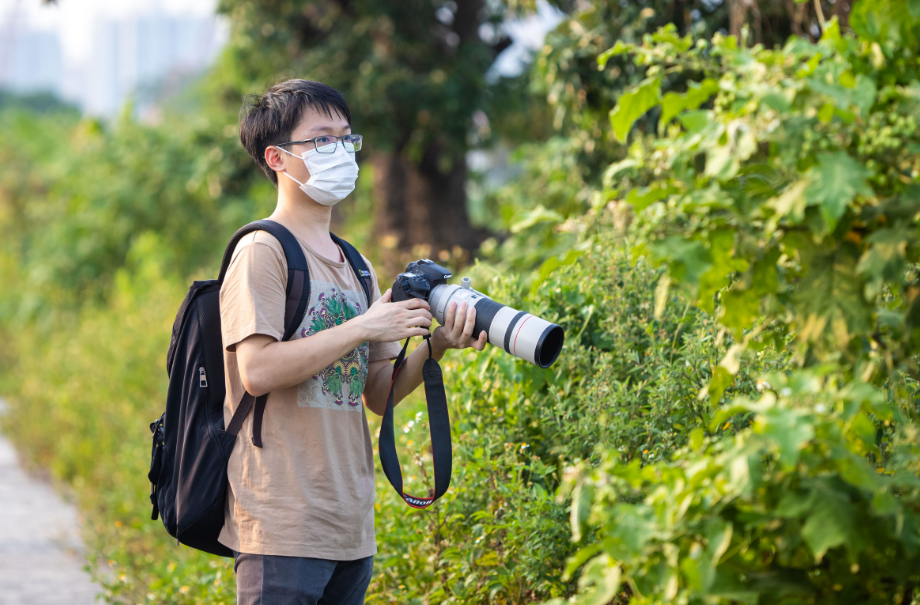
Wu Haolin, a senior bird watcher, photographed birds in Dajisha.
Interview notes
Day and night on the island in the middle of the river
Flowing green movement
Spread out the map of Guangzhou, the island in the middle of the river is like an emerald inlaid on the Pearl River. The island has flowers all the year round, fish ponds are all over the island, and egrets and birds sing in low voice. They breathe and grow together with the city. Jiangxin Island is one of the important ecological treasures of Guangzhou city.
After visiting several islands in the middle of the river, the reporter clearly felt that the islands in the middle of the river, which can't see tall buildings and are crowded with cars, are more likely to make people feel the life connection of nature.
The island in the middle of the river at night is surrounded by the river, and everything is calm. We visited the "elves" on the urban green island to listen to the heartbeat of nature. The moonlight is bright and the river breeze is blowing gently. In the trees and grass, the spotted legged pan tree frog with suction cups on its toes, the spider holding eggs, the lizard going out for food... Between day and night, the wild animals and plants on the island in the middle of the river live and multiply in a unique way. Exploring the island in the middle of the river at night, we can see the other side of the city. Cities are not only homes for human beings, but also habitats for wild animals and plants.
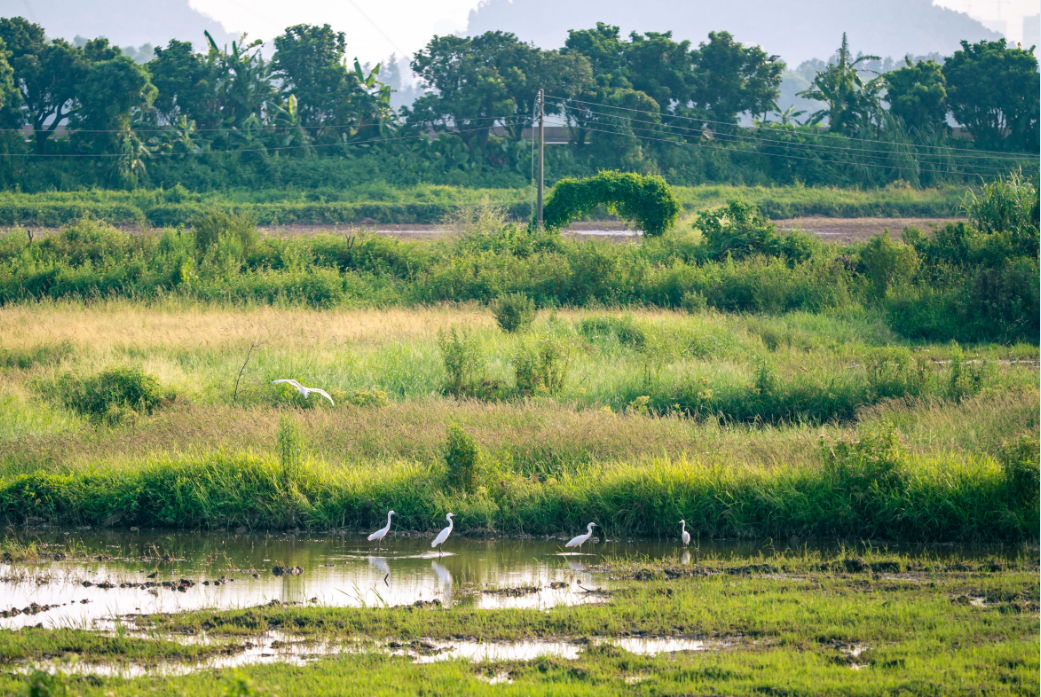
Egrets in Dajisha
Some experts believe that with the rise of high-rise buildings and crisscross roads, urban wildlife is facing habitat loss, fragmentation and other problems. The number of urban wildlife is gradually decreasing, and even many species are difficult to find in cities. Jiangxin Island has left precious habitats for these wild animals and plants. Guangzhou is taking measures to promote the creation and restoration of animal and plant habitats, strengthen the protection of animal and plant diversity, and attract more wild animals and plants to settle down in the city.
The High Quality Development and Construction Plan along the Pearl River Coast of Guangzhou (Draft) released in May proposed to strengthen the ecological protection of the islands in the middle of the river. Beidisha, Dazhou Island, Shazi Island and other islands in the middle of the river, with a total area of 37.4 square kilometers, should be protected according to three categories: strict protection, restricted development and optimized utilization.
To achieve harmonious coexistence, we need to protect the day and night of the island in the middle of the river and create a peaceful and safe habitat for wild animals and plants. Some cities in China have proposed to delimit "dark night protection areas" to control light pollution and help the ecological restoration of night areas. Let the quiet return to the quiet, the noisy return to the noisy, so that the city and ecological nature are harmonious.
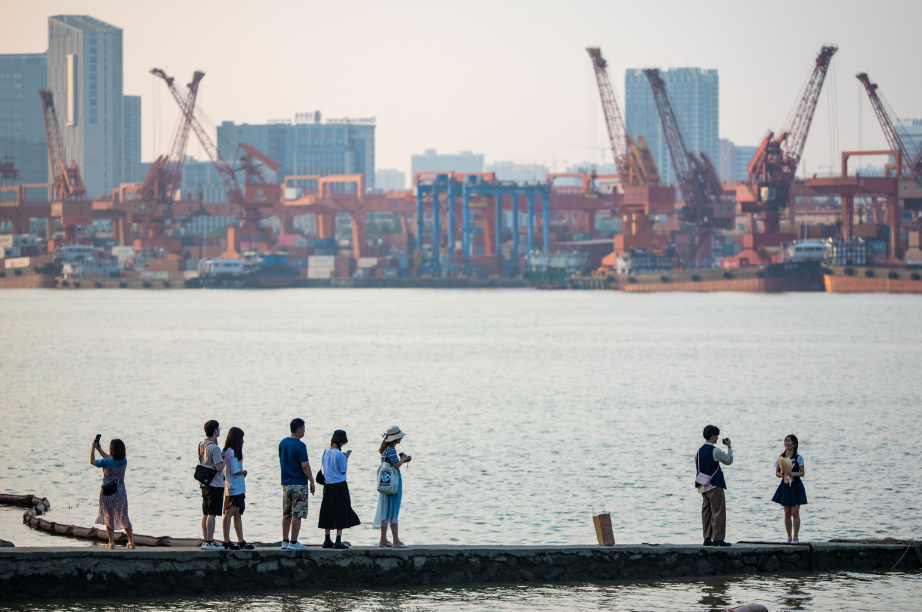
Tourists punch cards and take photos in Dajisha.
In fact, many undeveloped or semi developed river islands in Guangzhou are following this rule. There are not many residents on Dajisha Island, and there are only a few home stays. The ferry in and out of the island ends operation every 9 p.m. On the island, only a few street lights with moderate brightness are set on the roundabout road and residential areas. In the daytime, citizens and tourists are blowing the river wind and enjoying the beautiful scenery, and egrets are strolling in the paddy fields; At night, with the ferry stopping, Dajisha bid farewell to the hustle and bustle and switched to the quiet world of wildlife. In the dark, insects "sing" happily, and plants stretch their branches freely. In the day and night of the island in the middle of the river, people in the city and "elves" get close to each other and share the comfort of oasis in the middle of the river.

Planning/Jiang Yongzhong, Xu Fang, Lin Ming
Executive/Zhao Dongfang, Qin Hui, Zhang Weiqing, Yu Jing, He Chao
[Visit the team]
Overall leader/Xiao Guilai, Melvin
Article/All media reporters of Guangzhou Daily He Dianying, Wu Duo and Xiao Guilai
Picture and video/Su Junjie, a reporter from Guangzhou Daily
Video editor/Guangzhou Daily full media reporters Su Junjie and Huang Hongbin
Opening remarks/He Chao, a full media reporter of Guangzhou Daily
Layout design/Liang Qianwei, Tu Xiaobin, Xu Jinkun
Poster design: Liang Jiashun
(The original title was "Running of the Pearl River ① | Night exploring the fairies carnival on the island in the middle of the river")

























